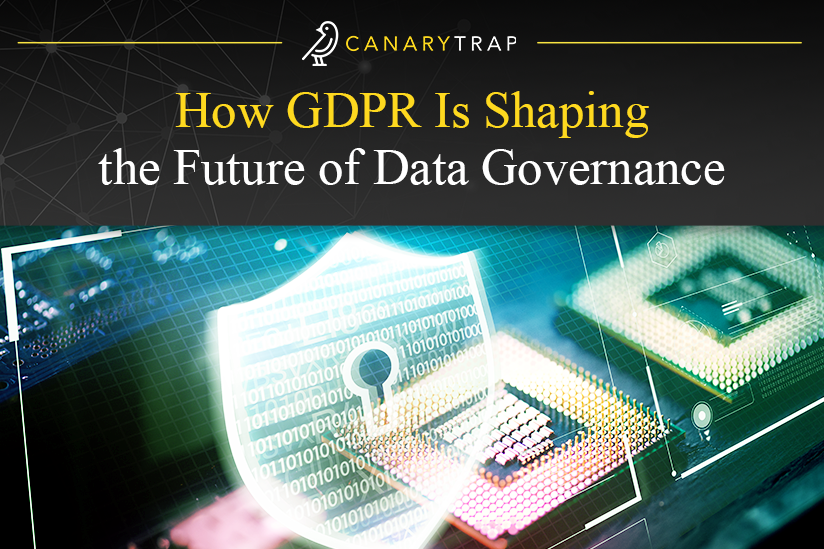How GDPR Is Shaping the Future of Data Governance
- February 16, 2024
- Canary Trap
In an era dominated by digital interactions and widespread data sharing, the General Data Protection Regulation (GDPR) emerges as a crucial shield against potential privacy breaches and data misuse. As technology permeates every aspect of our lives, the need to secure personal information has become more critical than ever. The GDPR, implemented in 2018, not only reshaped the way organizations handle data but also empowered individuals with greater control over their personal information. Let’s delve into GDPR compliance, dissecting its principles, implications, and the evolving role it plays in the cyber age. It’s not just a set of rules; it’s a paradigm shift in how we approach data protection and privacy.
The Evolution of Data Protection
The journey toward comprehensive data protection is a tapestry woven through historical events, technological advancements, and societal shifts. It extends beyond GDPR, reaching back to early notions of privacy and the gradual recognition of the need to safeguard personal information.
In our contemporary landscape, data protection has assumed unprecedented importance. As aptly stated by the Identity Management Institute: “Data protection is more important now than ever before because the amount of personal data at risk has increased, the potential consequences of a data breach are greater, technology has made it easier for personal data to be shared and accessed, governments are implementing more regulations, and there is a greater awareness of the importance of data protection.”
- Early Privacy Considerations
The roots of data protection can be traced back to ancient civilizations, where the concept of privacy, albeit rudimentary, began to take shape. As societies evolved, so did the recognition of the value of personal space and information. From the sealing of letters in ancient Rome to the protection of personal writings, rudimentary forms of privacy laid the groundwork for the broader principles we uphold today.
- Landmark Moments in Data Protection
Several pivotal moments in history paved the way for modern data protection regulations. The post-World War II era witnessed the recognition of privacy as a fundamental human right. The Universal Declaration of Human Rights, adopted in 1948, explicitly acknowledged the right to privacy. And subsequent milestones, such as the establishment of data protection authorities in Europe during the 1970s, further solidified the foundation.
Before the advent of GDPR, organizations faced a landscape marked by fragmented and inconsistent data protection measures. Varying privacy laws across different regions led to challenges in navigating a globalized digital ecosystem and the lack of a cohesive framework left gaps that malicious actors could exploit. The rising tide of cyber threats underscored the need for a more unified approach.
- Technological Advancements and Data Proliferation
The late 20th century witnessed an unprecedented surge in technological innovation and the proliferation of digital data. The advent of the internet and the exponential growth of online transactions created new challenges for privacy and data protection. With personal information becoming a valuable commodity, the need for comprehensive regulations became apparent.
As it was noted in an article published by Medium: “Over the past 15 years, we have seen the expansion of communication tools such as wireless internet, smartphones, tablets, and wearables as well as social media sites like Facebook, YouTube, and Instagram. These technologies have not only changed the way we interact with each other and the world, but how companies reach customers. As access to data has skyrocketed, so has the impact on privacy, and regulatory authorities around the world are reacting to the challenges that the digital age presents.”
- Catalysts for Regulatory Change
High-profile data breaches and privacy scandals acted as catalysts for regulatory change. Incidents like the Cambridge Analytica scandal, in which the company obtained and misused the personal data of millions of Facebook users without their consent for targeted political advertising during the 2016 US election and Brexit referendum, underscore the vulnerability of personal information in the digital age. Major events alike triggered a global conversation about the responsibility of organizations in handling user data, laying the groundwork for the emergence of GDPR.
GDPR: A Paradigm Shift in Data Protection
The General Data Protection Regulation (GDPR), implemented in 2018, still stands as a watershed moment in the history of data protection. Designed to harmonize data privacy laws across Europe and empower individuals regarding their personal data, GDPR introduced a new era of accountability, transparency, and user control.
According to information provided on the official GDPR website: “The General Data Protection Regulation (GDPR) is the toughest privacy and security law in the world. Though it was drafted and passed by the European Union (EU), it imposes obligations onto organizations anywhere, so long as they target or collect data related to people in the EU. With the GDPR, Europe is signaling its firm stance on data privacy and security at a time when more people are entrusting their personal data with cloud services and breaches are a daily occurrence.”
Key Principles of GDPR
GDPR is built upon several fundamental principles that organizations must adhere to when processing personal data. These principles include transparency, lawfulness, fairness, purpose limitation, data minimization, accuracy, storage limitation, integrity, and confidentiality. Understanding these principles is crucial for organizations striving to achieve compliance and uphold user rights.
Rights Afforded to Individuals
A central tenet of GDPR is the emphasis on individual rights. The regulation grants individuals significant control over their personal data, including the right to access, rectify, erase, and restrict the processing of their information. Additionally, individuals have the right to data portability and the right to object to certain processing activities.
GDPR Compliance Challenges
While GDPR sets a gold standard for data protection, achieving and maintaining compliance poses challenges for organizations. The regulation requires a comprehensive overhaul of data management processes, transparency in data practices, and the establishment of robust security measures. Striking a balance between innovation and compliance is a delicate yet imperative task.
The Global Impact of GDPR
While GDPR originated within the European Union, its influence extends far beyond these borders. The regulation’s extraterritorial reach means that entities worldwide must assess and adapt their data protection practices if they handle the personal data of EU residents.
According to the International Association of Privacy Professionals (IAPP), “privacy professionals say a lack of harmonization among EU member states, as well as continuing new and updated guidance, is an ongoing struggle. […] While the GDPR was billed by some as the silver bullet to fix the patchwork of privacy laws across Europe, supervisory authorities differ in their interpretations of the regulation and the interplay with other local laws present challenges.” Let’s explore the broader implications of GDPR’s global impact:
- Extraterritorial Scope
GDPR applies not only to EU-based organizations but also to any entity that processes the personal data of EU residents. This extraterritorial reach has prompted a reevaluation of data protection practices on a global scale.
- International Data Transfers
Organizations engaged in international data transfers must ensure that such exchanges comply with GDPR requirements. Adopting mechanisms such as Standard Contractual Clauses (SCCs) or Binding Corporate Rules (BCRs) is crucial for lawful and secure data transfers.
- Global Adoption of Similar Regulations
GDPR has set a precedent, inspiring other countries to bolster their data protection regulations. The LGPD in Brazil, the CCPA in California are just some examples of legislation created to align with GDPR principles.
- Impact on Multinational Corporations
Multinational corporations, in particular, face intricate challenges. They must harmonize diverse data protection requirements across jurisdictions while maintaining a unified approach that aligns with GDPR standards.
- Navigating Divergent Legal Landscapes
The coexistence of GDPR with other data protection laws necessitates a nuanced understanding of divergent legal landscapes. Organizations must adapt their strategies to meet the requirements of multiple regulations, fostering a cohesive and compliant approach.
As organizations navigate the global impact of GDPR, a unified and strategic approach is paramount. Recognizing the interplay between global regulations, understanding the nuances of extraterritorial application, and implementing tailored compliance measures position organizations to thrive in the evolving landscape of data protection. The journey to GDPR compliance becomes not only a legal imperative but also a strategic opportunity to fortify data governance practices on a global scale.
Navigating GDPR Compliance: Practical Strategies
As organizations strive to align with the GDPR framework, they face multifaceted challenges and complexities. Navigating the global compliance landscape requires practical strategies. Let’s delve into some key considerations and strategic approaches that organizations can adopt to ensure a robust and effective compliance journey.
Data Security Measures
Ensuring GDPR compliance goes hand in hand with implementing robust data security measures. Therefore, organizations must fortify their data protection frameworks to safeguard sensitive information. Let’s explore essential data security measures integral to GDPR compliance:
- Encryption Protocols
Adopting state-of-the-art encryption protocols is a cornerstone of GDPR compliance. This ensures that personal data remains confidential and secure, mitigating the risk of unauthorized access during storage and transmission.
- Anonymization Techniques
Anonymizing data means rendering it non-identifiable and it is a powerful strategy. By employing advanced anonymization techniques, organizations can process data for various purposes while reducing the risk of privacy breaches.
- Proactive Incident Response
Organizations must develop and implement proactive incident response plans. This includes continuous monitoring, detection, and swift response to potential security incidents to minimize the impact on data subjects.
- Timely Breach Notification
GDPR mandates the timely notification of data breaches to the relevant supervisory authority and affected data subjects. Establishing clear procedures for breach notification ensures compliance and builds trust in an organization’s commitment to data protection.
The Knowledge Academy, also lists Data Protection Impact Assessments (DPIAS) as some of the most effective compliance strategies: “DPIAs are used to assess and mitigate privacy risks associated with data processing activities. Their main goals are: identifying and evaluating potential risks to individuals’ rights and freedoms, implementing necessary safeguards, and documenting the assessment process.”
As organizations navigate the complexities of GDPR compliance, integrating robust data security measures, conducting regular audits, and embracing continuous improvement are pivotal. By viewing GDPR compliance as a dynamic and evolving process, organizations not only meet regulatory requirements but also foster a culture of data protection excellence. This dynamic approach positions them to adapt to regulatory changes, mitigate emerging risks, and uphold the highest standards of data privacy.
In Conclusion
In the dynamic evolution of data protection, the exploration of GDPR compliance and data protection in the cyber age reveals a complex narrative shaped by historical events, technological progress, and societal shifts. GDPR marked a pivotal moment, introducing principles like transparency, fairness, and user control, elevating data protection to a global standard. As organizations embark on the journey to GDPR compliance, strategic considerations emerge. Implementing robust data security measures, including encryption and anonymization, along with proactive incident response and timely breach notifications become fundamental to ensuring compliance.
GDPR compliance is not merely a legal obligation but an opportunity for organizations to fortify their global data governance practices. It requires a holistic approach, encompassing legal adherence, technological fortification, and a commitment to continuous improvement. As entities worldwide grapple with the challenges and reap the benefits of GDPR, they find themselves better equipped to navigate the complexities of the cyber age, safeguarding individual privacy and fostering a more secure digital ecosystem.
SOURCES:
- https://identitymanagementinstitute.org/evolution-of-data-protection-and-privacy/
- https://medium.com/@HubSpot/reflections-on-the-evolution-of-data-privacy-754bc31f3809
- https://gdpr.eu/what-is-gdpr/
- https://iapp.org/news/a/three-years-in-gdpr-highlights-privacy-in-global-landscape/
- https://www.theknowledgeacademy.com/blog/challenges-of-gdpr/#:~:text=Non%2Dcompliance%20is%20one%20of,reputational%20risks%20associated%20with%20violations.

